Century Plant (Agave Americana) and its origin
Century Plant (Agave) is a hardy survivor plant that can tolerate extreme heat and drought. This desert jewel has gray-blue leaves with long, recurring spines that grow into a basal rosette. Each of the leaves ends in a backbone of an inch or more, giving this plant much protection against strange animal predators. Native to North America, this giant Agave plant can be found in the southwestern United States and Mexico.
Giant Agave is a monocarpic plant. This plant gives a high flowering stem, similar to asparagus after 10 years or more, mostly at the end of its life. The stem may reach up to 30 feet straight up. The plant normally dies after flowering leaving an offset or “pupa” on the bottom, that starts a new life for the plant.
The plant of the century is propagated by disconnecting and transplanting the puppies well rooted from the base, or three seedlings formed on the flower peak.
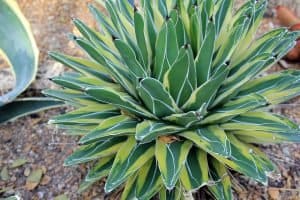
Scientific Classification of the Century Plant
Scientific name: Agave Americana
Kingdom: Plantae
Order: Asparagales
Rank: Species
Genus: Agave
Types of Century Plant
More than 17 species of Century Plants are found all over the world, but some of the species are commonly grown for their uses and benefits. We have listed some varieties of Century Plant.
Agave Americana
The American Century Plant Agave or Maguey in Mexico is usually called Agave Americana. This plant has very attractive blue-green leaves with conspicuous toothed spines.
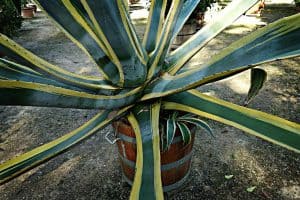
The common variety is the solid bluish color. There are many variegated forms, such as the American Marginata Amave. Both grow quite large and make good specimen plants in an open environment. On another side, there is another variegated variety of Agave Americana mediopicta with a central yellow stripe and green margins on the leaves.
Agave Attenuata (Foxtail Agave)
The agave Attenuata is also known as Dragon Tree or Foxtail agave. The Agave attenuata plant grows to a height of four or five feet and wide with a curved inflorescence which holds yellow-green flowers on the spike gained from the common name, attenuata fox agave.
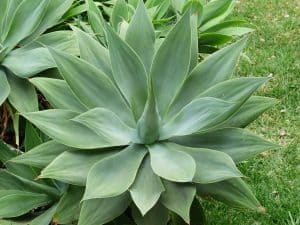
It is a spineless variety with soft, attractive, legible, and threat-free green leaves. When this plant is young, it makes an attractive home plant easy to care for.
Agave Tequilana
Tequila agave is also known as Weber’s Blue Agave, or simply the blue agave plant is called Tequilana Azul. It is the plant used to make tequila. It is also a good landscaping plant for high altitude gardeners.
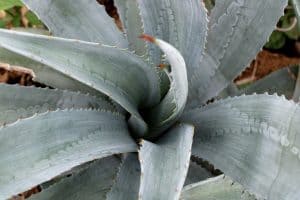
These plants prefer rich and well-drained sandy soils. Plants grow quite large and can last several years.
Agave Parryi or Parry’s Agave
Agave Parryi (Artichoke Agave) wonderfully beautiful plant, has black specks sharpened at the ends of broad, gray-green-green leaves. Grow on rocky and dry slopes. A sun-loving plant makes a beautiful specimen in a pot.
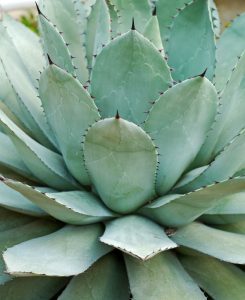
Agave Blue Glow
Agave Blue Glow is a small, slow-growing moist agave hybrid. Blue Glow grows a height of one or two feet with a spread of two or three feet and creates a dense rosette of lush green leaves.
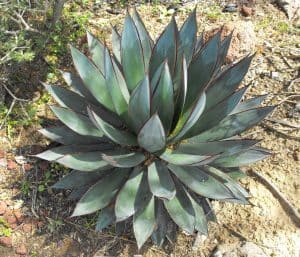
Blue Glow is a cross between Agave Attenuate and Agave Ocahui and was developed by Kelly Griffin Horticulture at Rancho Soledad Nurseries in Rancho Santa Fe, California.
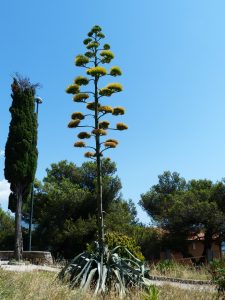
How to Grow Century Plant in the yard or garden?
Choose a portion in your yard that is large enough to accommodate to plant, and where it will not affect with structures or walkways. Plants of the century can grow over 12 feet and can be 6 feet wide. Plant the century plants where children can’t reach due to their acute spines.
Dig a hole enough to hold the root ball of the plant, but no deeper than the original plant. Place century plant into the hole and cover with soil. Water the plant a century after sowing. Continue to water once every two weeks.
How to Grow Century Plant in a pot?
Growing potted agave plants is a pleasure. Any species of Agave can be grown in a container, but the smaller varieties are the most popular. Agave plants love to tied to the roots, so if grown in pots, these plants are excellent candidates for houseplants. All agave plants need soil grown in a container that dries slowly but drains quickly.
For external containers, you can get a right soil mix by mixing compost in equal parts, potting soil or garden soil, gravel, and pumice or coarse sand. Don’t use peat moss, which is undesirable for growing agave plants.
For indoor Agave, be sure to use a sterilized dough combined with gravel, pumice, or coarse sand. When you plant Agave, don’t bury the plant too deep in the soil. Make sure that the top of the plant is overhead the soil line to prevent crown rot, a disease that is harmful to agave plants.
Lighting requirement for Century Plant
Grow plants in areas that receive full sunlight. Tolerant to some shade, aged plants will grow better in high light conditions.
How to Care Century Plant?
The century plant grows outdoors as well as indoors, so there are some tips listed below to take care of century plants.
- It requires light, porous soil, and for best results combine a mixture of sand, peat, and clay.
- It grows indoors at normal room temperature.
- It cannot survive in freezing temperatures during the winter. Therefore, bring it indoors or keep it indoors year-round.
- While outdoors, place it in a light, sunny area.
- Whereas in indoors, set it near a bright window, but avoid direct sunlight as it may scorch the leaves.
- Keep watering the plant plenty of water throughout the spring and summer.
- Water it every week between April and September.
- Stop feeding the plant at least a month before overwintering, feeding it too much before winter weakens the plant.
- During winter plant does not require water.
- The sharp spines and leaf tips pose a danger to children and pets, and If needed, trim the leaf tips with a pair of scissors.
Uses of Century Plant
Century plant has different uses from herbal remedy to medicinal purposes. Some of the uses of its are listed below:
- Century plant has antiseptic, healing, and anti-inflammatory properties, which can be used externally to treat burns, bruises, minor cut, skin irritation caused by insect bites.
- The laxative property of the plant also helps in the treatment of diarrhea and dysentery.
- The century plant is the source of hecogenin, which can be used for the production of steroidal drugs.
- The flower stalks and base leaves can be roasted and consumed.
- The sweet juice from the flowers is also useful to make an alcoholic beverage.
- And other species of Agava are also used to make traditional alcohol drinks such as tequila and mescal.
- The extraction of leaves or roots contains saponins, which have lathery property, also used to make soap.

Amelia is a plant and nature lover! Ever since she was little, she loved spending time in her family’s garden and learning about how to care for each plant individually. As an adult, she has dedicated herself to sharing what she has learned and continuing to expand her knowledge on the plant kingdom.
